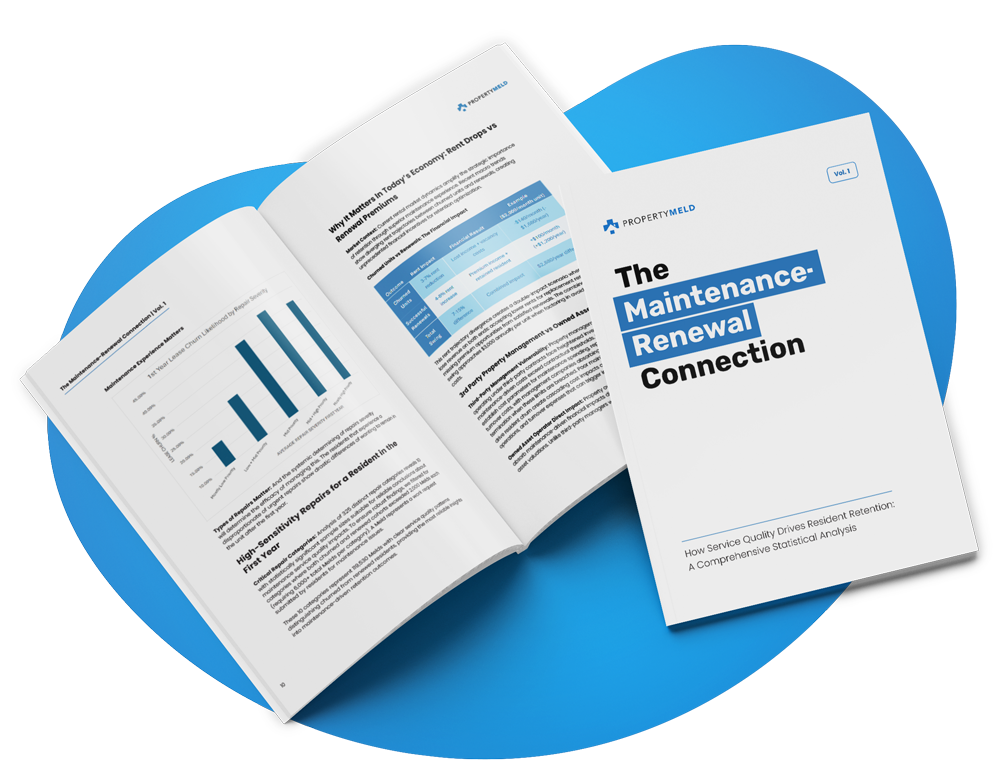For years, property management leaders have relied on instinct: if you keep up with maintenance, residents will stick around. The logic made sense, but the evidence was mostly anecdotal. Was maintenance truly the make-or-break factor in resident retention, or just one piece of a much bigger puzzle?
Now, the answer is clear. Property Meld’s new report, The Maintenance-Renewal Connection: How Service Quality Drives Resident Retention, analyzes 110,048 residents and 256,687 first-year work orders. The findings prove what many operators have long suspected: maintenance experience is the single strongest predictor of lease renewal.
And the implications? They’re bigger than most in the industry realize.
Why Maintenance Has Become a Financial Imperative
The cost of a churned lease goes well beyond vacancy. On average, each turnover costs $4,200–$6,800 per unit, with maintenance-related departures typically landing on the higher end.
But the bigger financial hit comes from rent trajectory:
- When residents renew, operators typically realize a 4–8% rent increase. On a $2,000/month unit, that’s an extra $80–$160 per month, or up to $1,920 annually.
- When residents churn, replacement leases often require a 3–7% rent reduction. That’s a loss of $60–$140 per month, or up to $1,680 annually.
Add those swings together and you’re looking at nearly a $3,000 difference per unit, per year, before even factoring in turnover costs.
For third-party managers, these numbers are especially risky. High turnover not only erodes NOI but also creates investor churn when maintenance expenses and vacancy costs push contracts out of compliance. For owner-operators, churn drags down property cash flow and even asset valuations, since cap rates reflect retention performance over time.
In today’s market, maintenance isn’t just a cost center, it’s a revenue strategy.
The Quality Gap Between Renewals and Churn
Our renewal report identifies stark differences between the experiences of residents who renew and those who don’t. Residents who churned consistently endured:
- Slower response times: 4.8–21.3% longer assignment delays.
- Higher communication burden: 3–17% more back-and-forth interactions.
- Lower satisfaction: 1–5% lower ratings on completed repairs.
These weren’t isolated patterns. They occurred across every major repair category, from air conditioning and heating to sinks, toilets, and refrigerators.
In other words, churned residents didn’t just get unlucky with a bad repair. They lived in a systematically different service environment, slower, less efficient, and ultimately less trustworthy.
The First 90 Days: A Make-or-Break Period
If there’s one period that matters most in shaping resident trust, it’s the beginning of a lease. The report found that first-quarter maintenance experiences predicted renewal with 73% accuracy.
Certain early issues were particularly damaging:
- Air conditioner failures: 98.5% increase in churn likelihood.
- Water heater problems: 93.7% increase.
- Toilet repairs: 90.2% increase.
Even less severe issues, like sinks, refrigerators, or dishwashers, spiked churn likelihood by 67–76% when they occurred in the first 90 days.
Think about what that means: the first three months set the tone for the entire relationship. A slow or poorly handled repair during that window creates an impression that lingers all year.
When Emergencies Tip the Scale
Another key insight: emergency repairs are strongly correlated with churn.
Churned residents experienced more high-priority emergencies across the board:
- 4.1% more HVAC emergencies (often tied to extreme weather).
- 3.1% more heating emergencies.
- 2.9% more water system emergencies.
Worse, those emergencies were often handled poorly, with longer assignment delays and more follow-up interactions. For residents, this created the impression that management couldn’t be trusted to handle critical situations.
Emergency responsiveness isn’t just about comfort, it’s about habitability. When residents feel unsafe or neglected during urgent repairs, they start making plans to leave.
The Hidden Patterns: Assignment Speed and Communication Burden
Two service quality patterns stood out across all repair categories:
- Assignment Speed Deterioration: Churned leases always experienced slower response times. Heating systems were the worst at 21.3% longer, followed by air conditioners at 12.7%.
- Communication Burden Escalation: Every repair category required more chat interactions for churned residents. For example, at-risk air conditioning repairs needed 17% more interactions than successful ones.
The takeaway is simple: speed and clarity are the frontline battles for resident satisfaction. Slow, communication-heavy repairs erode trust, while quick, decisive responses build it.
Tactical Adjustments to Boost Retention
The report doesn’t just outline the problem, it provides clear strategies operators can deploy to reduce churn. Here are four of the most impactful:
1. Launch a “No-Meld 90” Program
Eliminate high-risk repairs before residents move in by proactively addressing HVAC, water systems, and appliance issues during turnover. Cutting first-90-day requests by 50% could drop churn by 5–8 percentage points.
2. Set Strict Assignment Benchmarks
Adopt service-level standards for assignment times (2 hours for emergencies, 4 for urgent repairs, 8 for routine). Even a 25% reduction in assignment delays could improve retention by 2–4 percentage points.
3. Build Preventative Maintenance Around High-Risk Systems
Quarterly HVAC servicing, semi-annual water system checks, and targeted appliance inspections can dramatically cut emergency failures. Reducing emergencies by 30% could lower churn by 3–5 percentage points.
4. Move to Dynamic Dispatching
Instead of static vendor lists, use real-time performance data to prioritize vendors based on satisfaction scores, response speed, and past performance. Smarter dispatching could reduce churn by 4–6 percentage points.
Maintenance as a Strategic Advantage
The conclusion is inescapable: maintenance experience is no longer just an operational necessity, it’s a strategic growth lever.
- For investors, it safeguards asset values.
- For managers, it protects contracts and NOI.
- For residents, it’s the single most visible sign of care and reliability.
Repairs in the first 90 days of leases, emergency responsiveness, and assignment speed all combine to shape resident trust. And that trust, more than any marketing tactic or amenity, is what determines whether residents renew.
Want to see this research at a glance?
